The Moto G22 is a tidy budget phone, offering decent stamina and a competent main camera. However, terrible performance and a dim display should push you to consider paying just a little more.
Pros
- Stock Android 12
- Tidy, classy design
- Strong battery life
Cons
- Sluggish performance
- Low-res display
- Slow charging
-
Network skillsThis is not a 5G phone and it’s restricted to 4G networks. -
Charger includedIn the box you’ll find a 15w charger that can juice the phone from 0-100% in around 2 hours. -
Multiple rear camerasFour rear cameras, including a 50MP main; 8MP ultra-wide and a duo 2MP sensors.
Introduction
Motorola’s splurge of Moto G devices in recent years has muddied the once crystal-clear budget phone waters. It used to be simple – if you wanted to spend less than £170 on a smartphone, you bought a Moto G.
Nowadays, there’s a Moto G phone out there that costs as much as an iPhone. Following on from the £400 Moto G200 5G, however, Motorola has unveiled the Moto G22, which is much more in keeping with the original Moto G concept.
This is a phone that offers a smart design, clean “stock” Android 12 software, excellent stamina, and a competent camera for just £139.99. There are a couple of noteworthy catches, however.
Design and Screen
- Plastic but solid build
- No 5G but NFC
- 90Hz 720p LCD
There are no great surprises with regards to how the Moto G22 looks or feels. The brand has long made some of the most reassuringly solid cheap phones on the market, and that continues to be true here.
As always, the construction is all-plastic, but it doesn’t feel especially cheap or tacky. There’s a pleasing split angle to the frame, while the rear cover has a glass-like sheen. It does pick up fingerprints rather easily, however.
Our test model comes in Cosmic Black, but there are also Iceberg Blue and Pearl White variants available, if you prefer to make more of a bold statement. I quite like the stealthy approach for such affordable phones.
This is a fairly large phone at 163.95 x 74.94 x 8.49mm. However, that’s around the same dimensions as your average flagship phone, and it weighs a little less at 185g.
Motorola claims that the Moto G22 is “water-repellent”, but there’s no IP rating to seal the deal. To be fair, its inclusion at this price would have surprised somewhat.
You’ll find a 3.5mm headphone jack along the top edge, which is more or less expected in such an affordable phone. The bottom edge is home to the phone’s single speaker. You’ll need to splash out another £40 on a Redmi Note 11 for stereo sound.
On the positive side, Motorola has opted for a side-mounted fingerprint sensor, which is reasonably quick and reliable in use. This is a smart choice, since cheaper in-display fingerprint sensors can be horrendously slow and unreliable.
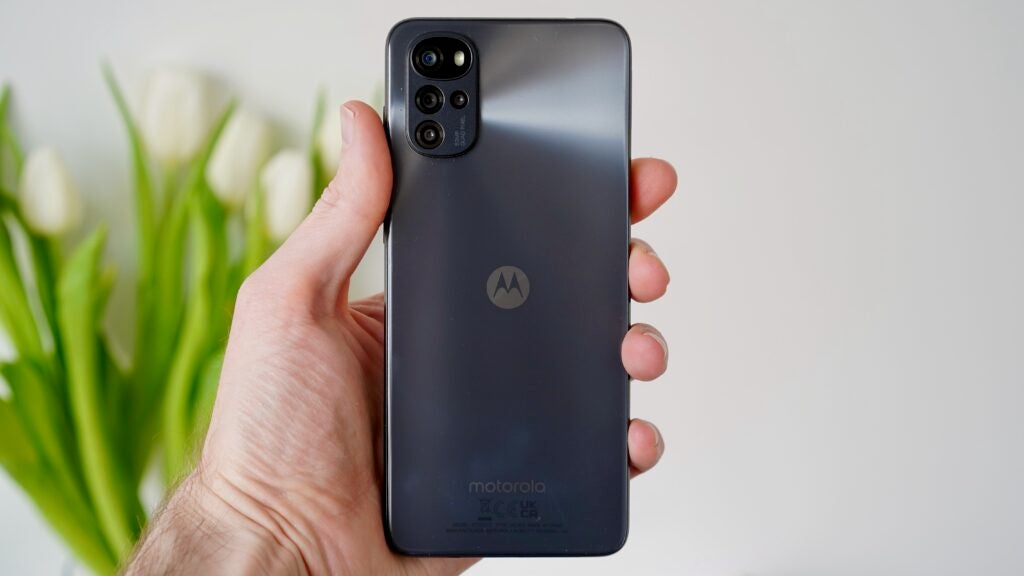
The Moto G22 display is generous in size at 6.5 inches – and it stretches to an impressive (for the money) 90Hz refresh rate, if you activate it in the Settings menu. However, that’s just about where the goodwill ends.
For one thing, It’s an LCD panel rather than the OLED included with the Moto G31 – which means it looks a little washed out. More problematically, it doesn’t get very bright at all. I left it cranked up to full or almost full the whole time, even in shady indoor conditions, and still could have done with more.
This screen isn’t very sharp either, with a resolution of just 1600 x 720 (HD+ or 720p). It looks reasonably clear in general navigation, but hold the phone next to a bog-standard 1080p rival and you’ll notice the difference – especially with web content and photos. Which, let’s face it, represents much of what you’ll be doing with this phone.
Elsewhere, while the inclusion of a 90Hz option is impressive for the money, it doesn’t really mean anything when performance is so poor. More on this later; but the stutter count is high with this device.
Suffice to say, a 60Hz OLED makes so much more sense than a 90Hz LCD on such humble hardware.
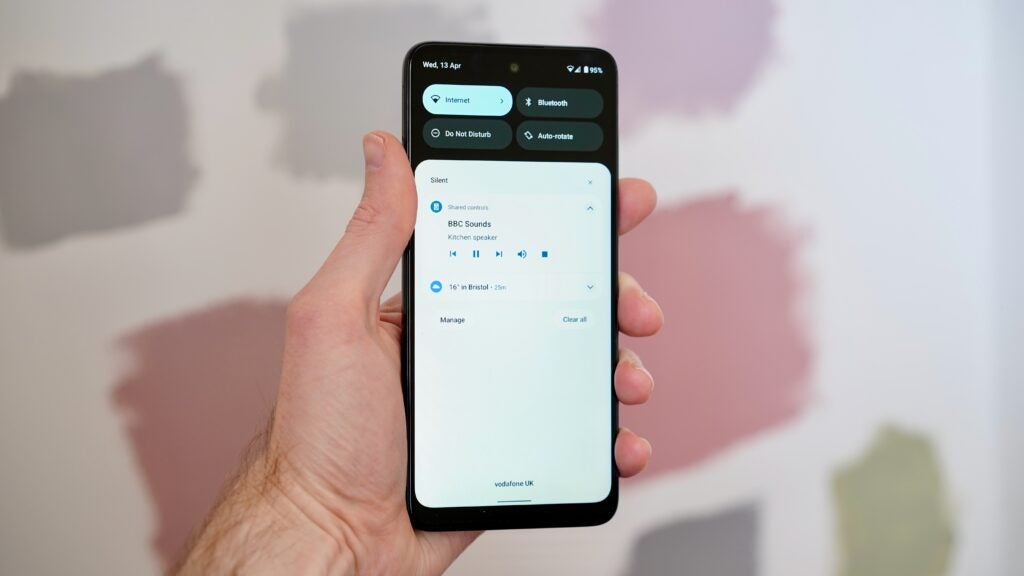
Camera
- Competent 50-megapixel wide camera
- 8-megapixel ultra-wide can’t match it for colour or detail
- Superfluous 2-megapixel depth and macro sensors
The Moto G22 packs in a quad-sensor camera system, although there are only two cameras of note: a 50-megapixel f/1.8 wide and an 8-megapixel f/2.2 ultra-wide. The other two slots are occupied by a 2-megapixel macro and a 2-megapixel depth sensor, which will be pretty irrelevant for most people.
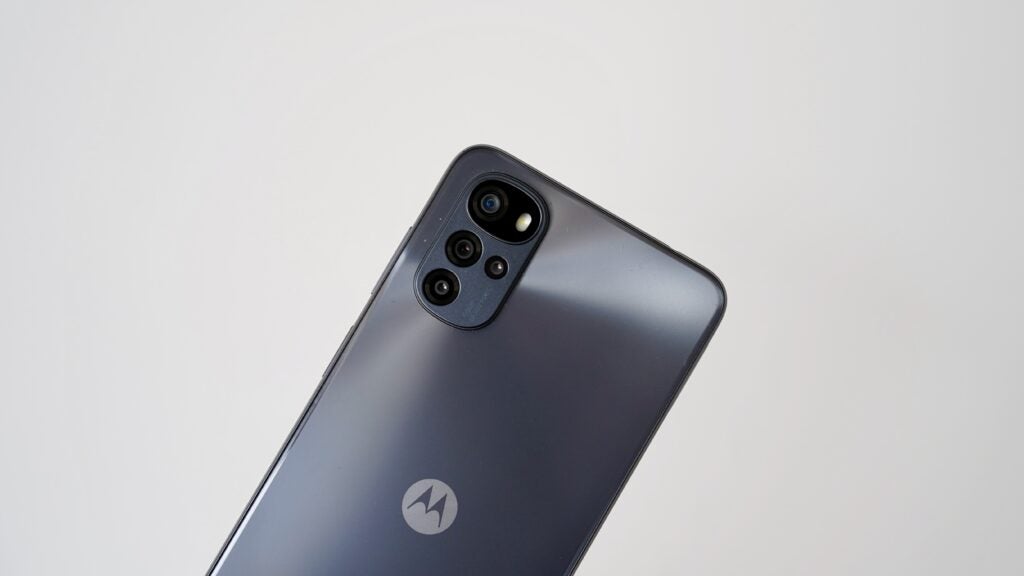
From what I can determine, it’s the same set-up as the Moto G31, with the addition of that depth sensor. This means that you get a perfectly adequate main camera that produces fairly sharp 12.5-megapixel shots using a 4-to-1 pixel-binning technique.
Feed this sensor with plenty of light, and it can produce pleasing results. There’s a hint of overexposure on brighter elements, but in general the auto-HDR does a competent job of balancing light and shade, and Motorola’s colour science doesn’t do anything too wacky or unnatural.
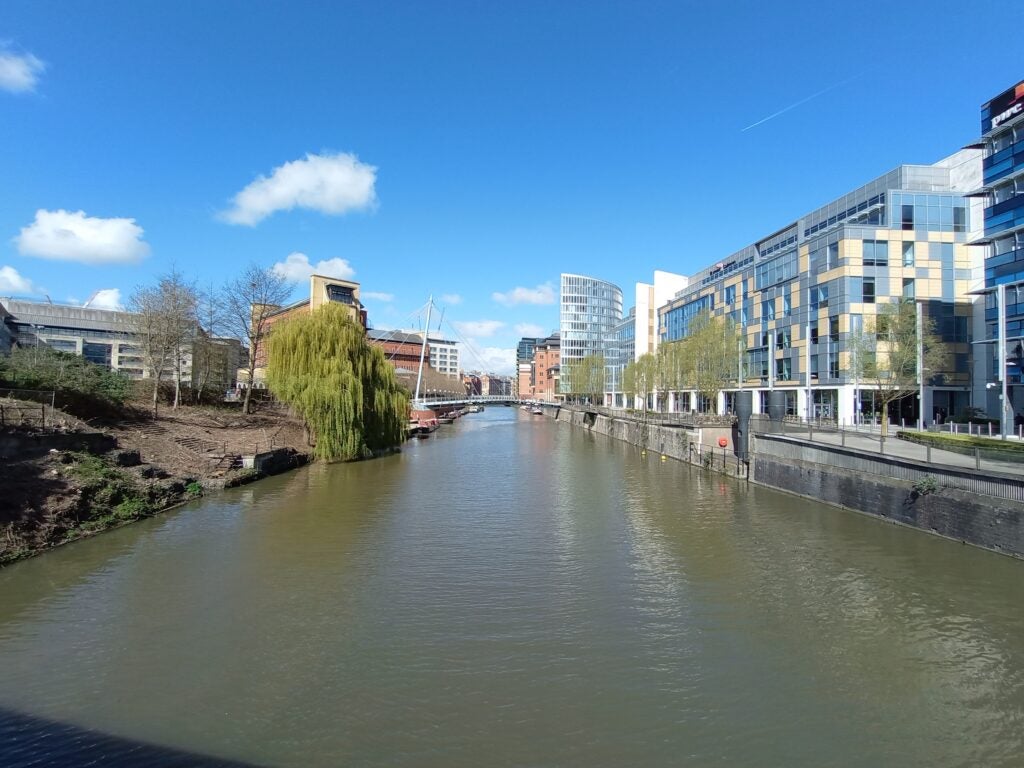
Lower lighting conditions cause the Moto G22 to struggle, however. While there’s a Night mode here, it yielded shots with so much noise that you’ll probably abandon even attempting to capture your evenings before long.
Unlike the Moto G50, the Moto G22 features an ultra-wide camera, which is a good thing. The tone of these shots is much cooler and flatter than results from the main sensor, of course, and there’s far less detail; but you’d expect that with any device in the budget category.
There’s also a 16-megapixel selfie camera around front – which, again, is capable of adequate results in good lighting. HDR fails to reign in particularly bright areas, and I noticed some blue sky noise – but it does its job.

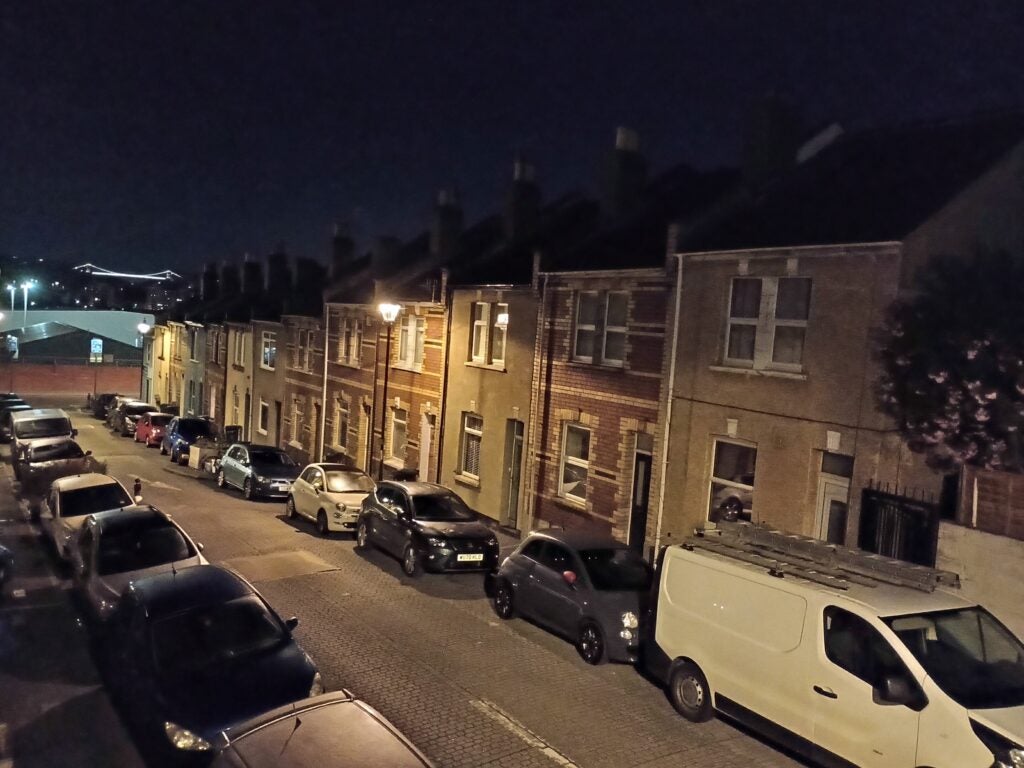

Performance
- Very weak MediaTek Helio G37
- Crisp, stockish Android 12
- No 5G, but NFC is present
Performance might just be the Moto G22’s fatal flaw, which I say with full acknowledgement that it’s aiming to compete with the other best cheap phones. The phone comes equipped with a MediaTek Helio G37, which comes up short even compared to the rest of Motorola’s current budget lineup.
As I’ve already alluded to, the Moto G22 struggles to maintain that alleged 90Hz display refresh rate once activated, with frequent halts and stutters when simply navigating between homescreens and apps, and even among menus.
This poor baseline performance is backed up by some woeful benchmark scores. An average Geekbench 5 result of 171 single-core and 943 multi-core falls way short of rivals costing just a fraction more.
Take the £180 Nokia G50, for example, with its humble Snapdragon 480 – which is a chip that has never knowingly impressed us. Nevertheless, it still managed to blitz the Moto G22 with scores of 510 single-core and 1593 multi-core. The Redmi Note 11, with its Snapdragon 680, is another budget phone that doesn’t set the world alight, but it still manages to score around twice as well in both single- and multi-core tests.
Indeed, the Moto G22 is closer in performance to last year’s bargain-bucket Moto E7i Power, which scored 129 single-core and 474 multi-core. That’s an £80 device.
The Moto G22 isn’t too impressive from a GPU perspective, either. 3DMark’s Wild Life test wouldn’t even run on the phone, while it scored a lowly 460 in the SlingShot Extreme test. The aforementioned Nokia G50 scored 2462, by way comparison.
Booting up that famously demanding GPU test, Genshin Impact, the game’s settings defaulted to Low – but it still proved downright unplayable. Even dropping those settings to Lowest still produced hulking great stops – “pauses” doesn’t quite cut it – in the action.
It’s worth pointing out that these performance issues have absolutely nothing to do with the Moto G22’s software situation. Indeed, the UI here is one of the phone’s key strengths.
As always with Motorola phones, you’re getting a pure Android experience with precious little in the way of customisation. In this case, that means Android 12 with its rounded notification shade icons and colour-coded wallpaper potential.
Nor is there an issue with the Moto G22’s other specs, with 4GB of RAM and either 64GB or 128GB of internal storage proving perfectly adequate. You can even expand that storage by up to 1TB via a microSD card reader.
On the connectivity front there’s no 5G, which isn’t a surprise this far south of the £200 mark. There is supports for NFC, however, which means you can pay for items with Google Pay in shops.
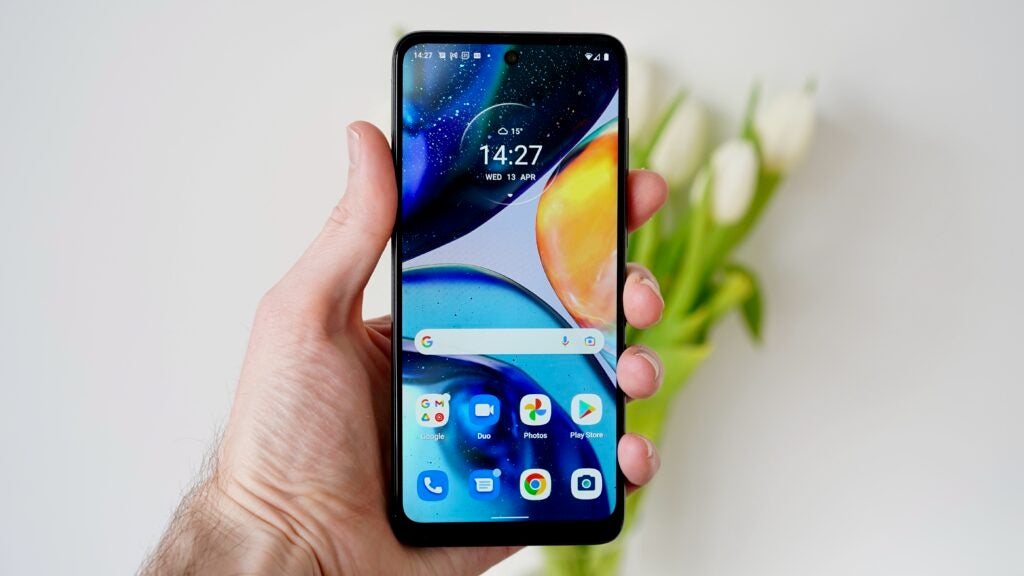
Battery Life
- Generous 5000mAh battery
- Good for two days of solid usage
- Slightly slow 15W charger
As well as keen pricing, solid build quality and clean software, you can generally rely on a Moto G phone to deliver strong stamina. Thanks to a 5000mAh battery and that dim 720p display, the Moto G22 doesn’t let the side down.
I was able to get through a full day of use, with 90Hz active and around 3hrs 30mins of screen-on time, with more than 50% in the tank. I’m confident I could have made it through a second day, as long as I wasn’t expecting it to be a particularly intense one.
With the default 60Hz display setting left active (you might as well, given those performance issues), this is certainly a two-dayer.
Such strong stamina isn’t exactly unusual at this end of the market, where large batteries and power-sipping displays are par for the course. But it’s still a strong mark in the pro column, without doubt.
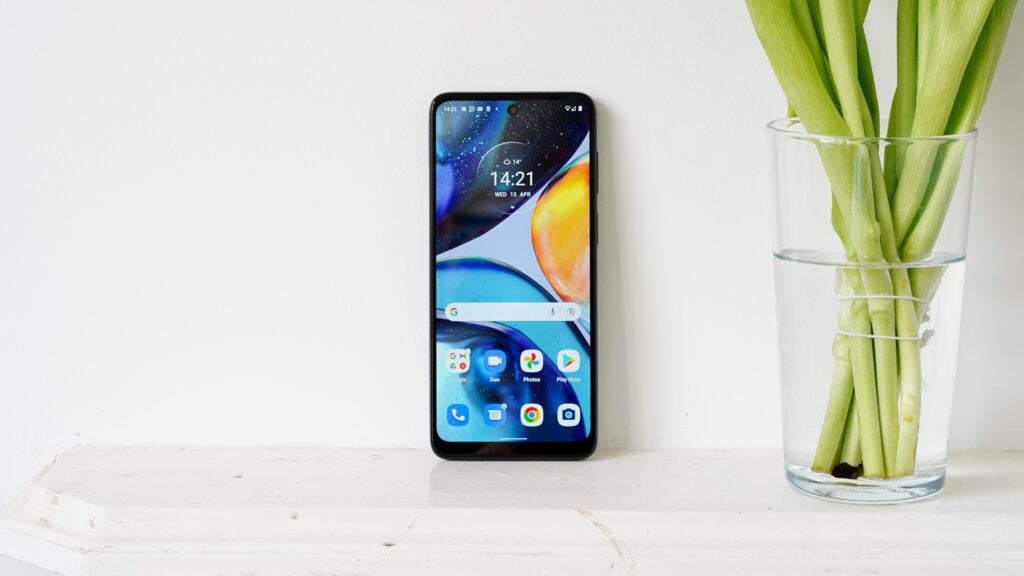
The G22 is quite efficient when it comes to running everyday tasks, too. An hour of Apple Music streaming sapped less than a single percentage point, while an hour of Netflix consumed a mere 3%. Of course, you’re not getting the full FHD/1080p resolution or full HDR with the latter.
As part of our regular suite of battery tests, we tend to run the 3DMark Wild Life stress test three times in a row, to see how much power is consumed from a full charge. However, the test wouldn’t run on the Moto G22, for the same reasons I outline in the Performance section. Bummer.
Recharging isn’t an especially rapid process with the Moto G22. You get a mere 15W charger in the box, which took just over an hour to get the phone from 0 to 50% in my experience. Getting from 0 to 100% takes a leisurely 2hrs 30mins, give or take.
The Redmi Note 11 comes with a much faster 33W charger for just a little more money, but at least the Moto G22 beats the woeful 10W brick supplied with the Oppo A54 5G.
Should you buy it?
You want a neat design for not a lot of money If your budget is just £140, you’ll struggle to find a better-built phone than the Moto G22.
You want a smooth performer The Moto G22’s performance is terrible, struggling for a consistent frame rate on homescreens and menus alike. It’s a complete write-off for 3D games.
Final Thoughts
The Moto G22 is another solidly built budget phone from Motorola. No other manufacturer makes quite such tidy, classy hardware for such little money.
Combined with stock Android 12 software, it’s one of the cleanest-looking cheap phones on the market. However, its atrocious performance and poor display make it tough to recommend.
We’re not expecting tip-top high-end gaming performance from a phone that costs less than £150, but we do expect it to be able to handle basic menu and homescreen navigation without constant stutters. It makes the mere provision of a 90Hz display option seem like a cruel joke.
Talking of that display, it’s one of the weaker examples we’ve seen of late, with a mere 720p resolution and poor peak brightness.
It’s a shame, because the Moto G22’s camera is competent for the money, its battery life is extremely strong – and, of course, it’s so very cheap. But spending just a smidgen more money will get you a far more fluid experience.
FAQs
This phone does not support 5G networks and is limited to 4G. Considering the price, this isn’t too much of an issue.
You get a 15w charger included with the phone
Full specification
Jargon buster
mAh
An abbreviation for milliampere-hour and a way to express the capacity of batteries, especially smaller ones in phones. In most cases the higher the mAh, the longer the battery will last but this isn’t always the case.
5G
Offering faster download and upload speeds when compared to 4G. Great for game streaming and HDR video playback. Not supported everywhere yet and speeds vary wildly.
GPU
The graphics processing unit is designed to render graphics, which is particularly important for gaming, creating 3D models and editing video.
















